Tutorial: Keyword Tagging in Apple Final Cut Pro X
In this first installment of our new tutorial series, Glen Elliott demystifies Final Cut Pro X, illustrates its core functions, and focuses on one of the most powerful new features for organizing, accelerating, and streamlining your edits: metadata keyword tagging.
Keywording in the Event Library
An Event is a collection of media. A Project is synonymous with a sequence or timeline in Final Cut Pro 7—it's an area where you're going to assemble your edit.
To begin working effectively in Final Cut Pro X, you're going to want to learn your way around the Event Library (Figure 4, below). It's one of the key areas where Final Cut Pro X shines. It's the place where you do all your metadata and keyword tagging, which is one of the major things that sets Final Cut Pro X apart from any other NLE on the market.
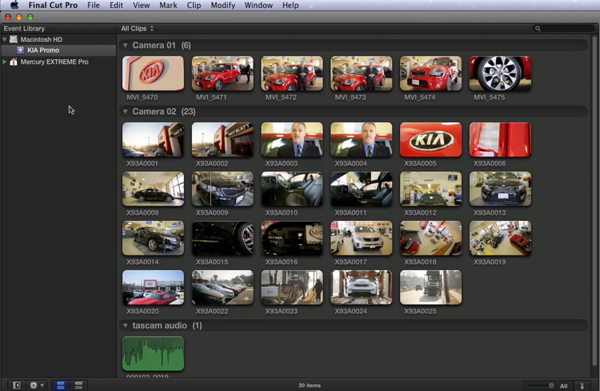
Figure 4. Close-up on the Event Library
This particular project is pretty simple. But for larger, more complicated projects, the process of categorizing your footage with keywords is going to make your job so much easier as an editor. Let's face it: One of our major jobs as editors is the process of culling hours of footage to find the pieces that tell your story.
Keywording is a great method of organizing your footage. The more organized and accessible and familiar you are with your footage, the more easily your edit will come together.
To access existing or add new metadata to any clip, click the thumbnail in the Event Library to highlight it and then open up the Inspector. Once you're in the Inspector, select the Info tab (Figure 5, below).
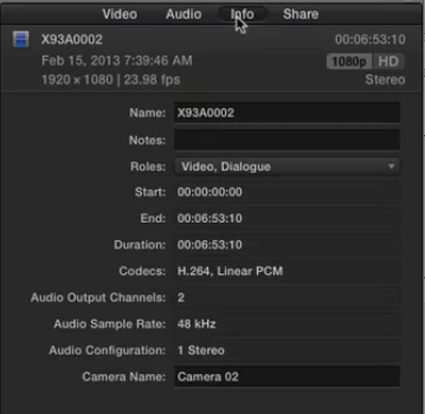
Figure 5. The Info tab in the Inspector
You'll see several attributes and parameters in the Info tab. Some are editable and some aren't. Down at the bottom of the Inspector, therere are also several different views you can toggle through to view all different types of metadata for your events (Figure 6, below). There's a ton of stuff in here.
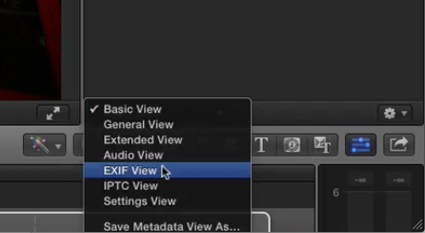
Figure 6. Other views
To begin keywording, highlight your first clip. Hit Command+K on your keyboard to bring up the Keyword dialog box. Then type in your keyword, hit Enter, and Final Cut Pro X will add the keyword to the particular clip (Figure 7, below).
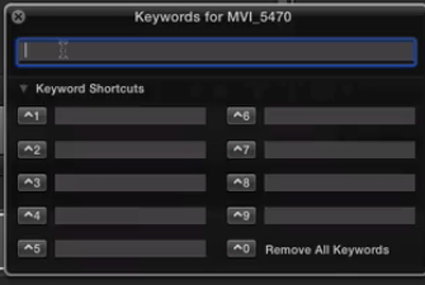
Figure 7. Adding a keyword in the Keyword dialog
Again, this is a very simple project—a promo that consists of a talking head with some B-roll. We're going to keyword it just to differentiate the talking head from the B-roll. So we'll start with Camera 01 and we're going to keyword this first clip as "b-roll." Once you hit Enter it's going to automatically populate the first selection below the keyword field, as shown in Figure 8 (below). When you go to tag the next clip that's considered B-roll, you can start typing "b-roll" and it'll actually finish typing for you. Just hit Enter. Or you can actually highlight another clip that's B-roll and just hit Ctrl+1 on your keyboard to tag it as B-roll.
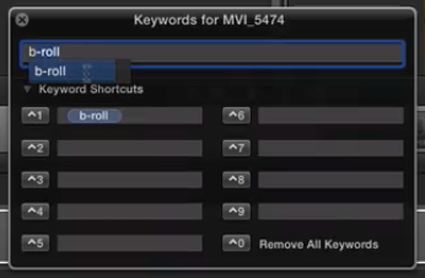
Figure 8. Tagging clips as B-roll
Now, you'll notice as soon as you keyword a clip, Final Cut Pro X adds a blue line near the top of its thumbnail to designate that it was keyworded. On the left in the Event Library, you're going to see a new keyword collection pop up. It basically looks like a blue page with a little key icon. Figure 9 (below) shows our keyworded clips.
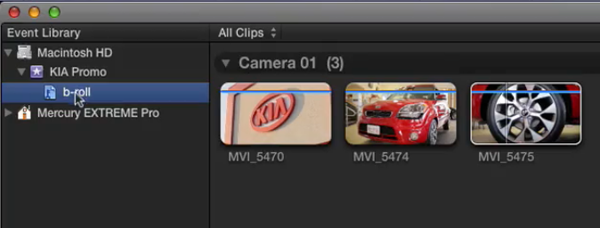
Figure 9. The blue line indicates that clip MVI_5470 has been tagged
Related Articles
Here's a look at two workflows for applying film grain to your footage in FCP X using cineLook (with and without Gorilla Grain), first with 4k footage shot with the Blackmagic Production Camera, and then with Cinestyle-flattened DSLR footage.
In our first tutorial on the recently released FCP 10.1, we look at the new Libraries feature, which enhances project and media organization and eases the adjustment for editors transitioning from FCP 7.
This tutorial on Apple Final Cut Pro X takes a closer look at color correction in the Inspector, exploring the Balance Color, Match Color, and Color Mask and Shape Mask features.
This tutorial on Apple Final Cut Pro X inspects the Video Inspector, a context-sensitive area of the FCP X interface that allows you to change settings of various filters and settings, and focuses on making basic but effective color adjustments.
In this video tutorial Glen Elliott of Cord3Films looks at FCP X's Timeline Index which provides innovative options for viewing, navigating, and searching your projects, including three different types of timeline markers and the ability to create a navigable To Do list of editing notes that's indispensable for collaborative workflows.
In this tutorial, Cord3Films' Glen Elliott demonstrates how to mix audio from multiple off-camera sources in a multicam edit in Apple Final Cut Pro X.
In part 2 of our series on multicam editing in Final Cut Pro X, Glen Elliott explains how you can accelerate and streamline the multicam-syncing process in Red Giant's PluralEyes 3.
Our Final Cut Pro X tutorial series continues with the first installment of a 3-part series on multicam editing in FCP X, addressing the basics like creating a multicam clip and cutting and switching audio and video using the Angle Editor.
Working with compound clips in FCP X is similar to nesting sequences in Final Cut Pro 7. Once you understand how it works, and how changes to compound clips can ripple across projects, it's a powerful feature that you'll find yourself using more and more.
In this tutorial, we'll look at several ways you can use connected storylines to enhance your FCP X edits and mix in cutaways and creative shots in a quick and efficient way.
This tutorial explores advanced editing techniques in FCP X including back-timing your edits, replacing edits and auditioning, top-and-tail editing, extend edits, trim-to-selection edits, keyboard trimming, and the Precision Editor.
The magnetic timeline is one of the major revolutionary changes in Apple Final Cut Pro X, and one of the areas editors struggle with when they're coming from track-based NLEs. In this tutorial we'll break it down and show you how to make it work for you.
No matter how fast, efficient, and determined a 48 Hour Film Project production team is, they need to finish strong with a streamlined edit. Final.revised editor Scott Strimple describes how Apple Final Cut Pro X allowed him to deliver the goods on deadline, by leveraging key features that could make any edit cook.
The 48 Hour Film Project offers filmmakers a chance at fame and glory and unleashed creativity, along with the insanity of producing a film from pre to post in two days. Scott Strimple, editor of award-winning 48HFP entries two years running, recounts what it was like putting together this year's film. In Part 2 he'll discuss the instrumental role Apple Final Cut Pro X played in editing and delivering the film with a cool 9 minutes to spare.
Background noise and pops and clicks in audio are an unfortunate fact of life for many productions. In this tutorial we'll explore some fixes you can try in Final Cut Pro X.
One of the most convenient new features in Final Cut Pro 10.0.6 is the ability to quickly and easily export to a single destination, or a bundle of destinations, that contain multiple outputs. In this tutorial, you learn how to create a single destination and a bundle of destinations.
The histogram and the waveform in Apple Final Cut Pro X are effective, easy-to-master tools that provide the clear input you need to diagnose and fix the contrast issues in your video simply and intelligently. In this video tutorial, video editing and encoding expert Jan Ozer explains how they work.